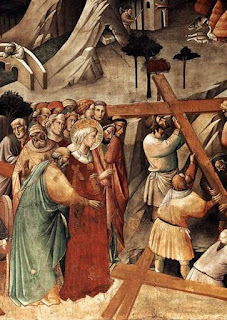It was found in an 11th-century Irish manuscript that includes the Vulgate Latin version of the four Gospels with St. Jerome's prologue, the Eusebian Canons that lay out the differences and similarities between them, the diagram of the game Alea Evangelii (seen here), and two pages of description of the game.
The instructions tell us that it was created at the court of the 10th-century King Æthelstan (ruled 924 - 939) by two men, Israel the Grammarian and an unnamed Frank, and brought to Ireland by the Bishop of Bangor, Dub Innse (who died in 953, so this manuscript was an Irish copy made later).
The game is called Alea Evangelii, the "Game of The Gospels," and is far more elaborate than the strategy game of tafl from which it derives. You can see from the illustration that it was a much larger board than the original, with many more pieces. The manuscript mentions:
If any one would know this game fully, before all the lessons of this teaching he must thoroughly know these seven: to wit, dukes and counts, defenders and attackers, city and citadel, and nine steps twice over.
It acknowledges that the current as well as the source game are about attacking and defending, but it is not clear from the diagram which is the offensive and which the defensive position. Also, tafl has only two kinds of pieces: a king and the rest. Alea Evangelii has more differentiations between pieces. Also, the pieces in Alea Evangelii are placed on the intersections of lines, not inside the squares. This makes it resemble the modern game of Go.
The four corners are each assigned to a different Gospel. A total of 67 pieces represent the Eusebian Canons. The pieces are black except for four red pieces, two for John and two for Mark (nothing for Mathew and Luke?). One black piece represents the unity of the Trinity. Each of Eusebius' Canons have a different number of pieces assigned to them, from the 16 pieces assigned to Canon I to the single piece assigned to Canon X.
Trying to figure out how it was played makes my head spin. A 1951 book, A History of Board-Games Other than Chess. (Oxford: Oxford University Press) by H.J.R.Murray tries to re-create it, or you can read the original ms. yourself.
Instead, I'm going to ask myself about one of the creators, Israel the Grammarian, who was considered one of the 10th-century's leading scholars. Tomorrow I'll tell you what I found out.






